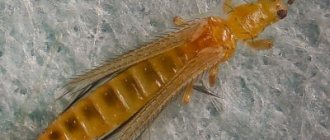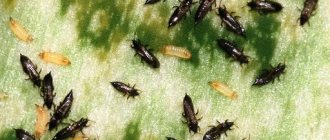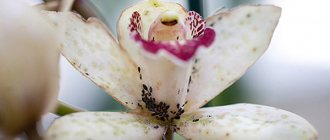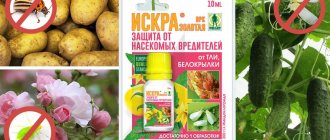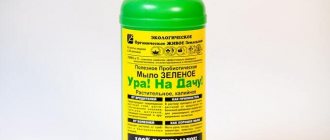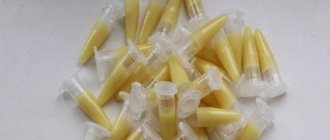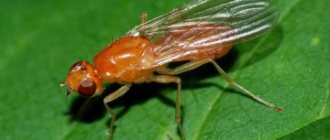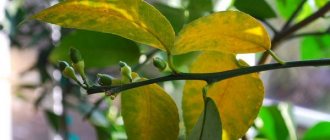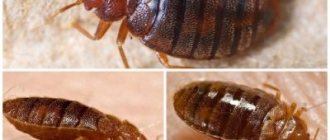- October 13, 2018
- Diseases and pests
- Khramenkova Elena
Thrips are dangerous pests. These insects attack all types of wild and cultivated plants. Due to their small size, it is impossible to see them on plants without a magnifying glass. The body of the insect has an oblong shape and a length of 2-2.5 mm. The color of the wings is dark, from gray to black. Thrips larvae are smaller in size and light in color.
How do thrips reproduce?
The female lays eggs on the entire plant. One female can lay up to eighty eggs, which hatch very quickly. In warm weather this will only take a few days. An adult insect can appear in almost sixteen days. In cold weather, this process can take several months. Wingless larvae hatch from the eggs.
On the inside of the leaves you can see small black dots, which indicate that a large accumulation of pests has appeared there. Below is a photo of thrips. The fight against them should begin immediately.
Initially, yellow or colorless spots, stripes or streaks appear. Over time, these spots and streaks merge, which leads to the death of plant tissue. As a result, the leaves wither and the flowers fall off prematurely, the entire plant withers and dies. If there is a large colony of insects on the flowers, then significant damage to the plants occurs, and “silver” areas become visible. Quite often the stems become bent. Traces of feces can be seen in the affected areas.
Signs of appearance
The pest reproduces on the reverse side of the leaf. On the leaves, the signs of a thrips attack are noticeable first of all - these are light transparent dots all over the leaf. As the colony grows and the infection progresses, the leaf begins to deform, takes on an ugly shape, the stem becomes crooked, and the inflorescences and ovary fall off.
The sucking of cell sap from tissues leads to the formation of discolored spots or streaking on the leaf. Over time, the streaks and spots merge into one large affected area. Plant tissue dies and holes appear on the leaves. Flowers may fall off without even drying out beforehand. Signs of “mass” colonization are a silvery coating and twisted leaves . Pest excrement can be seen on infected plants.
Symptoms of infection for different crops:
- Onions have light yellow spots on their feathers. With severe infection, the ends turn yellow, then the entire feather dries out. The bulb remains undeveloped and small.
- Cucumber and pumpkin . Angular spots form on the leaves. Over time, the leaves turn brown and the entire crop may die.
- Legumes . The fruits are distorted and the flowers do not develop. Gray or brown spots are visible on the pods. Damaged parts fall off.
- Roses . A sign of infection is darkening of the edges of the petals. Discolored spots may appear on the leaves. The affected bushes do not develop; the flowers on them are of an ugly shape.
Thrips are dangerous pests
You need to take a close look at indoor plants and pay attention to pollen, leaves and stems. The shedding of pollen on the petals is the initial sign that a pest - thrips - has appeared in the flower. The appearance of the plant becomes unsightly.
Begonias, palm trees, dracaenas, cacti - these are his victims, which he most often visits.
On the leaves of orchids, anthuriums, dracaenas and many other indoor plants, you can find the dracaena species of pests. The article contains photos of thrips. It is not easy to fight them. The size of the dracaena species is significantly smaller than the decorative one. The length of its body is 1.2 mm.
Common types of thrips
The first information about the existence of thrips was received back in 1744, when these pests were discovered by Karl de Geer. Today, people have become more aware of the species diversity of these pests, among which there are special species that infect ornamental plants more often than others:
- Western (California) flower thrips. This is a tropical species that can be found only in some regions of our country. The first fact of his presence was confirmed in St. Petersburg, when seedlings of carnations and chrysanthemums were delivered there. Today it is found in several dozen greenhouses and greenhouses;
- tobacco thrips. This pest lives in the middle zone and southern regions of our country. Here it is found on various ornamental plants grown in greenhouses and greenhouses. The insect itself is small, reaching a length of no more than 1 mm, and has a light yellow or brown color;
- decorative thrips. It is most widespread in the northern regions and central zone of our country. Poses a threat to many indoor plants. Orchids, monstera, dieffenbachia and certain types of palm trees suffer the most from this pest. It can be identified by its dark brown color, as well as a small body that is 1.5-2 mm long;
- dracaena thrips. Most often it can be found indoors in northern regions. Hibiscus, ficus, dracaena and a number of other indoor plants suffer from it more than others. The characteristic color of the pest is yellow-brown, the body is approximately 1 mm long;
- heterovorous (common) thrips. This species is represented in most of our country. The main food for it is flowers and buds of indoor plants. It looks like a dark brown insect, reaching a length of just over 1 mm;
- rose thrips. Its favorite habitats are rosaceous plants. A characteristic feature is a brown body, up to 1 mm in length;
- bulbous thrips. This species is represented in most of our country. Most often it can be found among the scales of lily plants. It can be identified by its dark brown color and body up to 2 mm long.
What to spray against pests
There are a number of pesticides that are used to control pests in open ground, but using them at home is highly undesirable. However, if you still have to use them, then it is best to take the pots with plants outside. Drugs like:
- "Mospilan".
- "Intavir".
- "Fitoverm".
- "Aktara".
After seven to ten days, repeat spraying. This must be done to consolidate the result.
Life cycle
Before becoming an adult, the pest goes through several stages: egg, larva, pronymph, nymph, adult.
The female lays up to 100 eggs . The cycle is affected by air temperature; the higher it is, the faster the eggs are formed. At 15−16°C they ripen in 15−20 days, at a temperature of 28−30°C - in 1–2 weeks. In a temperate climate in open ground, 1 generation most often develops per season; in greenhouse conditions, a pest colony can double in size in just a week.
The larval stage of thrips lasts 1–2 weeks, during which time the pest feeds little, sucking sap from plants. a pronymph with wing rudiments appears from the larva for 1–3 days At the next stage - nymphs , which lasts 2-3 weeks, the insect already has underdeveloped wings, but without a fringe the nymph cannot yet fly. Having turned into an imago - an adult , thrips begin an active life: they jump, fly, and eat.
The average lifespan of an adult pest is 30–40 days ; females in the population outnumber males by 2–2.5 times. In indoor conditions, the pest reproduces all year round; in open ground, it overwinters in plant debris in the form of larvae. The insect can withstand winters with little snow and frosts down to -40 ° C .
Indoor violets and pest
The first sign that thrips is present on violets is scattered pollen on the petals and the rapid wilting of newly opened flowers. You can take such a flower, pick it and shake it over a white or black sheet of paper. Elongated and small insects will begin to fall out of the flower.
And the greatest damage to violets is caused by thrips larvae. They destroy the anther of the flower. You can see thrips on violets in the photo. The fight against them involves a number of activities, for example:
- Buds and flowers should be picked off within one and a half months.
- Treat leaves and substrate with Fitoverm or Aktara.
- Use blue and yellow sticky traps.
Glue traps for thrips - in the photo.
We will consider the fight against them on other types of plants later in the article.
How to properly deal with rose pests
The greatest danger to roses are rose thrips - tiny and very voracious pests. They suck the juice from the leaves, but cause the greatest damage to the flowers. It is difficult to notice the presence of pests due to their small size. Only traces of damage can indicate the presence of pests on roses.
Using a magnifying glass, you can see thrips on roses in the photo below. The fight against them must begin immediately. Sick plants need to be immediately isolated.
If this is not possible, then those plants that are nearby will also have to be processed.
What preparations to use for spraying against rose pests? The following have worked well:
- “Fitoverm” (the plant needs to be sprayed, covered with a bag and left for one day).
- "Vermitek" (processing method like "Fitoverm").
- Actellik is a highly toxic drug.
Plants should be treated indoors using personal protective equipment. After a week, repeat the procedure. In the garden, large areas of damaged roses are best cut and burned. Dig up the earth.
Preventive measures
It is easier to prevent any disease than to treat it later. The same rule can be applied to pests of house plants. To get rid of or prevent the appearance of parasites in your apartment that want to profit from the juice of indoor flowers, it is enough to arm yourself with a number of rules and recommendations. For example:
- If you have already decided to keep house plants in your apartment, then you need to properly care for them. Caring for them also means inspecting the flowers every day for traces of the vital activity of pests such as thrips.
- Thrips can appear in conditions of insufficient watering of plants when the soil dries out.
- Pests can enter an apartment with a new flower purchased from a flower shop. It is better to first place it in a separate place and check whether pests have begun to multiply.
- Since thrips have wings and can fly, they can easily enter through an open window. Mosquito nets cannot always protect a room from these parasites.
- If you regularly treat indoor plants with infusions of celandine or tobacco, then these simple procedures can scare away uninvited guests.
The rules are not complicated at all, you just need to be patient and understand that ignoring these simple rules can lead to a negative result. Moreover, if it is not possible to detect pests on plants in a timely manner, then you will have to make every effort to save the flower or ornamental plant.
How cucumbers suffer from thrips
If yellow spots (mottling) appear on the upper side of the cucumber leaves, and a silvery color appears on the underside of the leaves, then we can talk about the presence of pests. This is the most dangerous enemy that leads to the death of the plant.
The photo above shows thrips on cucumbers. The fight against them includes a number of important measures, for example:
- Planting material must be disinfected.
- Use glue traps.
- If there are a large number of insects, you need to treat the plants with insecticides.
Effective drugs such as Fufanon, Aktara, Fitoverm (biological product), and Imidor are recommended against thrips on cucumbers.
If you still had to resort to treating plants with chemicals, you should carefully study the instructions and adhere to the waiting period after treatment.
Folk remedies for pests
You can use folk remedies to prevent and control thrips. The most effective infusions are tobacco and celandine infusions. You can use onion peel product.
After the completion of the cucumber growing season, it is necessary to carry out a number of final works to combat pests:
- Remove weeds and plant debris from around the greenhouse.
- Dig the soil deeply.
- Disinfect everything inside the greenhouse with bleach.
You should know that thrips are carriers of cucumber mosaic viruses.
Dangerous pests of orchids
The orchid is considered a very capricious plant. Most often, thrips are found on spathoglottis, faius, phalaenopsis, miltonia, cymbidium, catasetum and other representatives of the Orchid family. They can be attacked and harmed by thrips species:
- Californian.
- Tobacco.
- American.
- Dracaena.
There are a number of signs by which you can identify affected flowers:
- Silvery-white tint on the leaves.
- Deformation of flowering stems and new shoots.
The photo above shows thrips on orchids. The fight against them includes the following actions:
- Arrange a shower for the affected flowers. Try to wash away harmful insects.
- Isolate orchids in a separate place, away from other flowers.
- Monitor the room temperature.
- Maintain high humidity, as thrips love dry air and cannot tolerate humid air.
- Place sticky traps around the flowers.
You can use folk remedies to fight thrips:
- Use a soapy solution for spraying.
- Garlic infusion (peel and crush 5 cloves of garlic. Pour half a liter of boiling water. Leave for 4 hours. Apply the resulting solution with a brush to the affected area).
- Dilute olive oil (one or two tablespoons) in one liter of water and spray the orchids.
Many chemicals are also oil-based. These drugs have a good effect on pests, but have one serious drawback. They contribute to the destruction of the leaf in the sun. Chemicals that are successfully used to kill thrips on orchids:
- Pyrethrum powder.
- "Celaflor."
- "Neudorf."
- "Vertimek" and others.
Plants that are subjected to chemical treatment must be moved to partial shade for a period of two weeks. It is necessary to strictly follow the instructions for use of the drug. When spraying, it is recommended to maintain a certain distance from the spray can to the flower.
Granular preparations have shown their effect on thrips well. They are placed in the substrate. Many of these drugs contain fertilizers. It is especially important when using granular preparations to be able to correctly calculate the dosage. Otherwise, the orchid roots may suffer from increased amounts of salts. Treating orchids once is not enough. It is necessary to repeat the procedure after 5-7 days.
Traditional methods of fighting thrips
Folk remedies are of little help in getting rid of harmful insects. In case of mass damage to plants, use insecticides. But if there are few insects, then you can use one or more home methods.
Whatever you use to treat your plants against thrips, follow the rule: treatments with folk remedies are carried out 3-4 times with an interval of 3 days - to destroy the larvae hatching from the eggs.
Lather
The method is suitable for palm trees, ficus, orchids and is not suitable for plants with delicate or pubescent leaves. Laundry, tar or green potassium soap are suitable for processing. But it’s safer to take shampoo for cat and dog fleas. In extreme cases, dishwashing detergent will do.
When treating a houseplant, be sure to cover the outside of the pot, tray, and window sill and window frame with soap foam. A teaspoon of ammonia added to a glass of soap solution will enhance the effect.
The leaves and stems are treated with a soap solution, the plant is covered with polyethylene and left overnight. If alcohol was used in the treatment, the plants should be washed 15 minutes after applying the foam.
Sticky traps
You can buy a ready-made glue trap in the store. Practice shows that more thrips end up on yellow plates. The trap is a piece of paper covered with a layer of special glue, crawling through which insects get stuck.
The disadvantage of this method is that the glue traps not only thrips, but also any other insects.
Garlic tincture
Crush 3-4 large cloves in a garlic press and pour a glass of hot water. Insist for a day. Strain and spray the stems and leaves of plants affected by thrips. You can do it simpler - do not infuse the garlic, but finely chop the cloves and scatter them near the plant, covering it with an air-tight cap. After a few hours, the smell will spread throughout the entire air volume and the pests will die.
Marigold decoction
Tagetis are used not to destroy, but to repel pests. Take 1 cup of crushed flowers, add a liter of water and bring to a boil. Turn off the heat and leave the broth for three days. Strain the finished tincture and spray the plants with a spray bottle.
Mineral oil
This treatment method can cause great harm to the plant, so use it only when absolutely necessary. Add a few drops of kerosene or machine oil to a glass of water and spray the plants with a spray bottle. For the same purpose, you can use ordinary polishes for indoor plants containing wax, which makes the surface of the leaves invulnerable to the mouthparts of thrips.
Prevention plays a major role in reducing the number of pests. Thus, thrips often enter the room with bouquets purchased and brought home. Therefore, if there are many valuable indoor plants in the apartment, then in order not to think about how to get rid of thrips, it makes sense to put a taboo on purchased flowers from the greenhouse.
Dangerous pests on gladioli
Thrips also pose a great danger to gladioli. This small pest causes irreparable damage to the plant. Its buds and flowers are especially affected by thrips.
The photo shows thrips on gladioli. Fighting the pest is difficult because it is located under the scales of the bulbs.
The main damage is caused to the corms, and this can happen even at the storage stage. If you look closely at the tubers, you can see crusty spots. The color of the peel is brown. The first step is to immerse the corms in hot water heated to approximately +50 °C. You can also throw away heavily infected bulbs and treat healthy tubers before storing.
Above are gladioli tubers, possibly affected by thrips (pictured). The fight against them begins with prevention.
As a preventive measure, you can carry out repeated spraying with Decis solution. Absolutely all tubers need to be sprayed: both sick and healthy. Repeat the procedure two or three times. Fans of folk recipes can use infusions of tobacco, yarrow and celandine.
You need to start the fight against thrips on gladioli by harvesting and storing the bulbs. Before storing for winter, the bulbs must be treated with the drug “Maxim”.
You need to continue to fight thrips in the spring, as soon as the initial phase of leaf growth begins. The plants should be sprayed for the first time. Absorbable drugs are used against thrips:
- "Phosbecide."
- "Iskra-bio".
- "Fitoverm".
It is necessary to spray gladioli seedlings at intervals of three weeks.
Ways to fight
Thrips are omnivorous, but indoors they often settle on ficus, lilies, violets, balsams, gloxinia tubers, orchids, and begonias. There is a possibility of infection of dracaenas, myrtle, gardenias, roses, palm trees, and citrus fruits.
In living rooms it is better to fight thrips using folk methods. To detect pests, sticky traps are used, which are sold in stores for flies.
Self-made products are more effective. You need to mix honey, rosin, petroleum jelly and castor oil , cover pieces of cardboard or plastic with the mixture. Thrips are attracted to the smell. Their number is rapidly decreasing.
Various control methods are also used in greenhouses and conservatories. For strawberries, cucumbers and other vegetables, folk remedies are preferable. Sticky traps are also effective on closed ground. In large areas they must be hung above the plants (distance 20 cm).
Folk remedies
If thrips are detected on an indoor flower, it must be urgently and carefully isolated (insects should not scatter). To reduce the number of pests, the plant is washed in a shower with warm water. Then it is advisable to wipe the foliage with an alcohol solution (1x1) and wash it again. Damaged parts of the foliage must be removed (they are not able to participate in photosynthesis), buds and flowers must be cut off.
Expert opinion
Vera Ivanovna Sh
Since childhood, I have been interested in growing indoor flowers, then I decided to devote my life to landscape design and gardening.
The effectiveness of the treatment increases if the flower, after thoroughly washing the roots, is transplanted into a new (necessarily disinfected) soil mixture. The place where the contaminated pot stood should be washed with laundry soap.
For the purpose of prevention, it is advisable to treat all indoor flowers using one of the traditional methods:
- infusion of citrus peels (for 200 g of peels, a liter of water, after boiling, the liquid is cooled, water is added to 3 liters);
- ash solution (half a glass of ash per liter of boiling water, leave for two days, use for wiping leaves);
- pour 30 g of red pepper into a glass of water, cook for an hour, for spraying, add 10 ml to a liter of water;
- pour a teaspoon of mustard powder into 1 liter of water and use to water the soil;
- Pour 100 g of tobacco into a liter of water, leave for 24 hours, add laundry soap before spraying;
- pour 60 g of dandelion leaves or roots into a liter of warm water, after 5 hours you can use it for spraying;
- pour a teaspoon of chopped garlic into a glass of boiling water, use it for rubbing after a day;
- Pour 400 g of the above-ground part of celandine with water, it can be used within a day;
- Boil the onion peel for 2 minutes; you can use it for rubbing immediately after cooling.
In case of severe infection, it is necessary to use store-bought drugs. Indoors and when processing vegetable and fruit crops, it is important to strictly follow the manufacturer’s instructions.
Store-bought drugs
In large areas of open ground, biological and chemical preparations purchased in stores are more often used.
Not only the plants are processed, but also the soil. Spraying should be carried out in warm weather immediately after the dew has dried. Since eggs are preserved after treatment, repeated treatment is required after 7-10 days.
Popular store-bought drugs:
- Confidor - affects the nervous system of adult insects and larvae, 3 weekly treatments are required.
- Karbofos - valid for 2 weeks, for ornamental plants per 8 liters of water 60 g, for vegetable crops per 20 liters 60 g, 10 liters of solution are required per 100 m2.
- Actellik - causes the death of insects when they enter the digestive system, treatment is carried out at a temperature of +15-28 ° C, one ampoule (1 ml) is enough for a liter of water, after treatment it is advisable to cover the plants with polyethylene for a day.
- Fitoverm is a biological product, consumption indoors is 2 ml per 200 ml of water, for garden flowers 16 ml per 10 liters of water, for vegetables 20 ml per 10 liters of water, pests die after a few hours, re-treatment is carried out after a week (the eggs are preserved) .
- Vermitek - penetrates into plants; after spraying indoors, it is advisable to cover the plant with polyethylene; in the garden, the treatment is carried out in dry weather, protection lasts a month.
- Intavir - suitable for all crops, insects die after the solution penetrates the digestive system; when treating indoor plants, they are covered with polyethylene for a day.
- Decis - the temperature during treatment should not be higher than +25°C, indoors the dose is 4 times less than outdoors, protection lasts 2 weeks.
- Spintor 240 - safe for people, animals, used for flowers and vegetables, protection lasts 3 weeks.
Prevention is always better than treatment . In open ground, thrips are less likely to appear, if there are no weeds, the plants are watered regularly. Air humidification and regular spraying help indoors. It is important to regularly and carefully inspect the flowers to start the fight on time.
How to save grapes
Thrips activity on grapes can be noticed in the spring. Damage begins with the budding buds. Gradually, insects move to the foliage and ovary. Next, the leaves become covered with growths under which the larvae live. Then the larvae transform into insects.
The photo shows thrips on grapes. The fight against them at the initial stage includes:
- Treatment of the plant with the preparation “BI-58”.
- Spraying with Fitoverm at intervals of three weeks.
- Repeated treatment of plants with folk remedies, infusions of dandelions and celandine.
Specialty stores sell glue insect traps that will help reduce the number of insects on grapes.
By finding out what thrips are and how to deal with them, you can save your plants from death.
